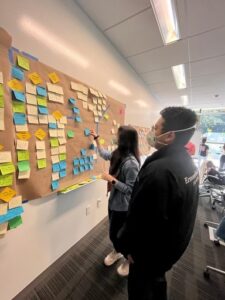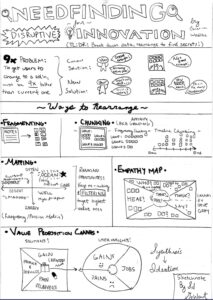I really enjoyed CS 247B this quarter! I took this class as the HCI requirement for my intended CS Minor, and was nervous, because before this class I never thought of myself as an “HCI Person”. I used to think about design in the same way before I took my first d.school class – how could I be a designer? I’m not creative, I’m not good at art/drawing – this will be far out of my comfort zone! However, after I took my first d.school class, I realized that there is no “correct” way to be a designer. I let myself feel silly during brainstorms, tried random ideas, let myself be creative, and had a great time. The exact same thing was true for this course! I walked in armed with nothing but my d.school learnings from last year (and whatever I had learned in the first two weeks of CS 147 this quarter) – and ended up having a great time. I still don’t consider myself an “HCI Person”, but only because I do not plan to do it as a future career. I feel much more comfortable with HCI concepts, and would love to take another 247 or HCI course in the future. I already have brought some of the concepts to one of my workplaces! The Haas Center is working on increasing student engagement with the space, and we have design-thinking based meetings. I brought a lot of lessons from this quarter’s class to those meetings, and have already created a change that will go into effect in early spring!
 Putting on my dinking cap to find trends!
Putting on my dinking cap to find trends!
The teaching team made the syllabus and course structure incredibly open to new designers – there was never a time where I felt fully out of my element, even though Figma prototyping and Sketchnotes really pushed me! In terms of what I loved: I would definitely keep Sketchnotes going throughout the quarter. Although they were a bit more time-consuming and stressful to create than normal notes, in the long-run they helped me retain a lot of the major concepts from the readings. A quick skim of my earlier Sketchnotes was great to remind myself of the main points, and the process of creating them forced me to find creative ways to show concepts. Through this quarter, I have gotten in the habit of including small sketches in all of my class notes – a lot of the time, those doodles are what I remember when I reflect on my class experiences.

My favorite Sketchnote!
This quarter’s team based approach really worked for me. I think all of us entered this course with a similar level of commitment, and while that varied at times, I felt like the team was overall open about capacity and what each member needed. I am leaving with a positive memory of everyone’s commitment! One thing that might be fun in future years would be team based ethics discussions. I know my team met every week at a set time, and if we had some reflection prompts around ethics to bring to class, that could make discussions a lot more lively.
I was really surprised that a team of mostly students who didn’t know each other worked so well. I expected that we would get everything done (we are all Stanford students, after all), but the dynamics, meeting times, workload, and general vibe worked great throughout the quarter. I was also pleasantly surprised at the teaching team’s flexibility. For example, we had one week where multiple team members were out with medical emergencies. That extra day allowed us to catch our breath and submit work that reflected us – not a rushed version of us. At the start of the quarter, there was one day I was incredibly overwhelmed, and remembering that I had extra time to do my Sketchnote saved me from pulling an all-nighter or being consumed by my stress.
I don’t think this is a problem, but I think it would be nice to have a period where we can go back to our original interviewees and talk to them about the product that we created from our takeaways from them! This is the one struggle that I always feel in design classes at Stanford – we only have 10 weeks, so we don’t really have time to go back and share our findings with the people who made it possible. I can do it with my friends who participated, but it might be hard to share findings with everyone individually.
This project has made me really aware of how tech traps consumers for profit. The research we had to do on scrolling and understanding the mechanisms behind scrolling behavior has made me incredibly cynical of using social media “just for fun”. The prevalence of ads, the addictiveness of short videos, and the learnings from this course have left a sour taste in my mouth when it comes to how social media algorithms run – but I think that is a good thing to know! I was also reminded heavily of Stanford flake culture when I saw how many people dropped out of our studies.
Ten years from now, I expect to remember three things: first, the grace the teaching team showed for assignments. Two, the power of drawing out notes. And three: the harm and power of scrolling on social media. These are all general, but I already see myself thinking about these things every day. I especially hope that the first point is something that I can include if I ever teach a class or lead a project or anything – that empathy matters a lot.
If I were to give one suggestion for a redesign of this project, I would think about trying to get study participants earlier and for a longer period of time. This would definitely make the course harder, but by having people go through the process alongside us, I expect that their teachings will be even more valuable and relevant to our design process.
I really enjoyed this course’s heavy focus on ethics. No other course I have taken has had as consistent of a focus on ethics throughout (other than the courses I took for my Ethical Reasoning requirement).
From week 3’s course on Nudging and Manipulation: Our product interrupts the variable ratio reward system that scrolling is based on. Usually, scrolling on Instagram will result in just a few great posts, and the vast majority of them will be irrelevant or just average. By breaking up the feed with suggestions of activities or alternatives, reminders of your goals, and having more spaces for personal reflection, SpamMe will break that reward system by pumping the feed with posts that break your unintentional swiping. I believe that these nudges are acceptable because the user will only seek out and use our product if they want to change this behavior. There are some use cases I can foresee that we would need to address: for example, we will need to be very mindful of how we post about things like exercise and physical health. Suggesting that somebody sit outside for a couple minutes might not harm somebody’s mental health, but repeated reminders to eat healthy or to work out could have really harmful effects for people who struggle with disordered eating or body image issues. Our group will need to make sure that the contact we share with our users takes factors like this into consideration. I personally am very conscious of who I follow and how social media makes me feel, and I want to extend that care to users.
In response to the ethical considerations around privacy – this is a place where our group has drastically changed our approach! We talked about this in our group writeup, but just a recap, we decided to go from having SpamMe be a bot that is connected to someone’s log-in and user profile to something created outside that simply interacts with user data. Since we already expect users to be sharing information about their interests, I imagine that the step of information would be pretty useful for hackers – by reducing the information we have that we don’t need, we can worry less about privacy concerns. One thing we will have to do is make sure that the bots that we create are secure and don’t share any personal data with other Instagram users!
When thinking about Design Justice, our team did hone in on our “Social Sally” persona. Sally scrolls on social media unintentionally and does not time-box her usage. Since we designed for somebody with certain traits, our intended user does have some specific habits. Similarly to privacy, however, our product really doesn’t have to know much about a user’s personal demographics. We don’t need that info, so in theory anyone who wants to change their social media could use our app. We did go based off of a persona, and since we are all young, able-bodied college students, our personal biases and design choices are definitely meant to be appealing to us. If we were to launch this product, I think we will need to do a little bit more work to address this and move towards a universal design approach: since social media is ubiquitous, and essentially used by everyone, there is reason to expect that everyone might want to use our product.
In comparison to the start of this course – Now, I think that design can play a role in any type of development or team building. It is crucial for setting goals, getting your team on the right path, and making sure you know where you want to go. Now, I think that I am a designer, and can learn and implement any skills that once intimidated me. Bring it on, post it note walls! Now, I think I can learn things on the coding side of HCI too! While you won’t catch me entering any art contests soon, I am armed with a tool kit perfect for sketching, and a basic understanding of how colors and graphic design can impact the look and feel of a product. And finally, now I KNOW that I want to take at least one more design course like this one before I graduate!
Next time when faced with a design challenge, I will trust myself to know how to approach the problem. If my team is struggling to align on a concept, I can whip out my notebook and sketch out what I’m thinking. If I don’t know what solution to go with, I know how to run an intervention study, or how to derive and test my key assumptions before I make a fool of myself with a product no one needs or wants. And next time I am worried about my skill in design, I know that I have completed a full quarter of an HCI class and had a great time doing it!
Thank you Christina, Alyssa and Medha for a great quarter, and to all the students in this course! I hope you all have a great spring break.



